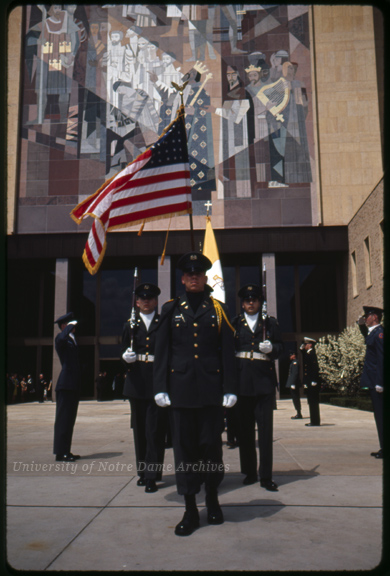
Notre Dame’s Memorial Library (renamed the Hesburgh Library in 1987) was formally dedicated on May 7, 1964. Its doors officially opened for student use in the fall of 1963, although the famous “Word of Life” mural wouldn’t be installed until the following spring.
Lemonnier Library (now called Bond Hall) was the previous library and opened in 1917 after having outgrown its space on the fifth floor of Main Building. A few decades later, rumblings for a new library could be heard on campus. On April 17, 1945, University President Rev. J. Hugh O’Donnell outlined the future of Notre Dame in his keynote speech to the Alumni Club of Chicago at Universal Notre Dame Night: “The need for a new library building also becomes more apparent every day. When it is built, the present structure will comfortably, but no more than comfortably, house the Wightman Memorial Art Gallery, the archives, and the museum” [Alumnus, June 1945, page 6].
In 1950, University Archivist Rev. Thomas McAvoy lamented the lack of space needed for the newly acquired General William Tecumseh Sherman Family Papers. Alumnus wrote, “Until a new library is built on the campus, and the present structure [Bond Hall] is turned into an art gallery and museum, students and visitors to the campus will be unable to view the collection of possessions and mementoes of the famed Civil War commander, since there is no room to exhibit it under present conditions” [Alumnus, March-April 1950, page 18].

The idea for a new library wouldn’t become more concrete until University President Rev. Theodore M. Hesburgh announced the Challenge fundraising campaign in 1958. Like his predecessors, Hesburgh had big dreams for Notre Dame. He had a grand vision for a large library that would continue to elevate Notre Dame as a premiere institute of higher learning. As with any ambitious building project, funds need to be raised and sites need to be considered. Some location options for the new Memorial Library included the razing of Main Building, a building long in need of repair and expansion. Another potential site was in between Sorin Hall and Bond Hall, but the site finally chosen was on the eastern outskirts of campus with anticipation of growth of the quad north of Notre Dame Stadium.

Ground was broken in the summer of 1961, after razing most of Vetville and Navy Drill Hall. Construction advanced rapidly and the 14-story building was topped out on April 3, 1962. Books were moved out of Lemonnier Library and Memorial Library was ready for occupancy on September 18, 1963.

The last step in construction was to install the famous “Word of Life” mural, commonly known as “Touchdown Jesus.” Father Hesburgh recognized that a massive building with few windows needed ornamentation as a counterbalance. On a trip to Mexico, Hesburgh was inspired by iconography on the Central Library at the Universidad Nacional Autónoma de México in Mexico City. Notre Dame hired artist Millard Sheets to design a mural for the new Memorial Library with Christ the Teacher at the center, surrounded by prophets and scholars of the Catholic Church. As Hesburgh intended with the physical building, the mural united Church and education, a concept often at odds with modern secular scholars.

The mural consists of over 6000 pieces of granite in a multitude different colors and textures found in quarries around the world. The pieces were cut and assembled at the Cold Spring Granite Company in Minnesota. The mural itself is not attached directly to the building, but floats in front of it. There is a bit of space in between to allow for the expansion and contraction of materials during weather changes. During installation, tarps covered the work so that the mural would not be seen until complete. The strong winds of Northern Indiana did not always comply and allowed visitors to peek through the blowing tarps to the artwork underneath.
The Memorial Library Dedication ceremonies in May 1964, were filled with all the traditional Notre Dame pomp and circumstance. On May 6, Eugene Cardinal Tisserant, Dean of the Sacred College of Cardinals and Prefect of the Vatican Library, celebrated Solemn Pontifical Mass on Library Quad, and Albert Cardinal Meyer, Archbishop of Chicago, said the homily. The third Cardinal in attendance was Joseph Cardinal Ritter, Archbishop of Saint Louis, who blessed Memorial Library on May 7th. As noted in Notre Dame, “Presidents of 15 college and universities, ranging from Princeton in the East to California in the West, were among 25 celebrated figures who received honorary degrees from Rev. Theodore M. Hesburgh, CSC, Notre Dame’s president at the convocation” [1964 Special Issue, page 3].

A salutation from Pope Paul VI read at the dedication declares, “We gladly send you Our greetings and felicitations on the dedication of the new Memorial Library at Notre Dame. We pray that this additional repository of wisdom and knowledge may serve as a valuable instrument in the pursuit of truth and the defense and development of faith. It will undoubtedly enhance the prestige of the University, and increase its efficiency in the academic mission so highly praised by Our illustrious Predecessor, Benedict XV. … Rejoicing, therefore, on the inauguration of the new Memorial Library, and praying that it will contribute richly to the advancement of truth, We invoke upon the University of Notre Dame an abundance of illuminating divine graces; and in pledge, thereof, We lovingly bestow upon you, beloved son, and impart to the professors, students and personnel, Our particular paternal Apostolic Blessing” [quoted from Notre Dame, 1964 special issue, page 2].

Sources:
Scholastic
Alumnus
PNDP 10-He-01
PNDP 83-Nd-3s “Notre Dame”: Special Issue for the Notre Dame Memorial Library Dedication, 1964
UNDD
GPHR 45/4739
GPHR 22/02
GNDL 5/30
GDIS 20/10
http://video.nd.edu
“Visualizing the Modern Catholic University: The Original Intention of ‘Touchdown Jesus’ at the University of Notre Dame,” by Margaret M. Grubiak
“Word of Life Mural,” Hesburgh Libraries (http://library.nd.edu/about/history/mosaic.shtml)
Words of Life by Bill Schmitt
